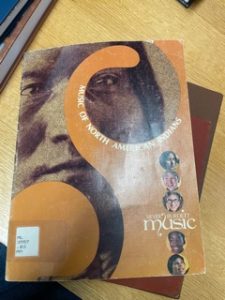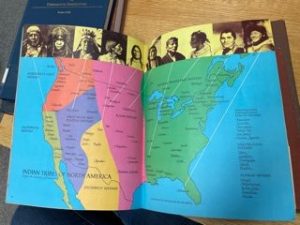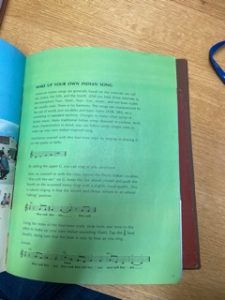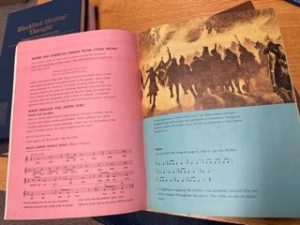 St. Olaf’s Halvorson Music Library is home to an exciting and surprising collection of primary sources that we can and will use as we develop our final mapping projects throughout the remainder of the semester. Recently, in both our projects and class discussions, we have been asked to consider the ways that members of the St. Olaf community should study music made and disseminated by Indigenous people.
St. Olaf’s Halvorson Music Library is home to an exciting and surprising collection of primary sources that we can and will use as we develop our final mapping projects throughout the remainder of the semester. Recently, in both our projects and class discussions, we have been asked to consider the ways that members of the St. Olaf community should study music made and disseminated by Indigenous people.
Accompanying the question of how Indigenous music should be studied, one of the more serious questions that we’ve considered in our class, is how much of the kind of language that we associate with Western art music should we use in our discussions of other musical traditions. Alongside this question, we have emphasized the significance of incorporating the voices of Indigenous practitioners and scholars into our study of Indigenous music. Scholars like Trevor Reed or Tara Browner are voices that we’ve engaged with as we try to discern the existing scholarly conversation surrounding the study if Indigenous music.
Louis W. Ballard’s 1975 textbook-style guide to Music of North American Indians offers an interesting complication to the consideration of the ways that we study music made by Indigenous peoples and the language we should use to talk about it [1]. Ballard’s book provides a map that places various groups of American Indians according to their tribe and affiliation, description and photos of instruments, as well as performance practice and composition-style instructions. Ballard was of Cherokee-Quapaw descent and is known for his compositions that combine elements of traditional Native American music and western classical music [2].
instruments, as well as performance practice and composition-style instructions. Ballard was of Cherokee-Quapaw descent and is known for his compositions that combine elements of traditional Native American music and western classical music [2].
 As an Indigenous practitioner of Cherokee music, Ballard’s booklet provides an intriguing perspective on how an Indigenous musician might use the language of western classical music to describe one’s own traditional music for a broader audience. In Ballard’s career, he composed pieces like “Incident at Wounded Knee” (1974) which narrated the 1890 massacre of Oglala Sioux at Wounded Knee in 1890. This piece premiered with the St. Paul Chamber Orchestra. Another one of his pieces,“Katcina Danses,” were inspired by traditional Hopi musical practice.
As an Indigenous practitioner of Cherokee music, Ballard’s booklet provides an intriguing perspective on how an Indigenous musician might use the language of western classical music to describe one’s own traditional music for a broader audience. In Ballard’s career, he composed pieces like “Incident at Wounded Knee” (1974) which narrated the 1890 massacre of Oglala Sioux at Wounded Knee in 1890. This piece premiered with the St. Paul Chamber Orchestra. Another one of his pieces,“Katcina Danses,” were inspired by traditional Hopi musical practice.
http://https://www.youtube.com/watch?v=BoIZ7uBh1Nk
Though Ballard refers to many different Indigenous musical practices in his textbook, it is important to acknowledge that his perspective does not hold sole authority over the characterization of Indigenous music and culture. Ballard’s book was used as an educational tool and was catered towards a younger audience most familiar with standard Western musical notation. His book offers one perspective, but ultimately makes some interesting characterizations of the “Music of North American Indians.” The booklet is written from an Indigenous perspective, but ultimately creates many, potentially problematic, broader generalizations about Indigenous music practice as a whole. It can also provide valuable information about the development of education surrounding Indigenous music practice. Ultimately, when considering the best ways to decolonize our listening practices and continue an ethical and equitable study of Indigenous music, one point-of-view doesn’t ever provide a comprehensive viewpoint, regardless of who is providing that perspective.
Footnotes
[1] Ballard, Louis W. Music of North American Indians. Morristown, NJ: Silver Burdett Music, 1975.
[2] Perea, John-Carlos. “Louis Ballard.” Encyclopædia Britannica. Encyclopædia Britannica, Inc. Accessed November 8, 2021. https://www.britannica.com/biography/Louis-Ballard.

